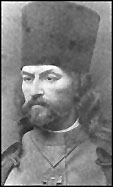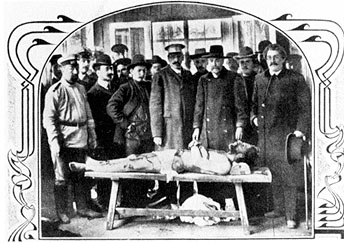Georgii Gapon (in Russian) graduated from the St. Petersburg Theological Academy in 1903. His missionary work with the poor had attracted the attention of the authorities, and Gapon was invited to become involved in an effort by Sergei Zubatov (1864-1917), one-time head of the Moscow branch of the Okhrana (the tsarist secret police), to create "police-sponsored labor groups" (take a moment and think about that phrase a bit)--This effort has often been called "police socialism." When Zubatov was expelled from the movement, the Assembly of Russian Factory and Plant Workers fell under the control of Gapon.

Gapon's Assembly grew rapidly in size through 1904 to maybe
eight to ten thousand workers. And while the police remained
nominally involved, Gapon also hoped to realize a far more radical
program for the workers. At the end of 1904 the firing of several
assembly workers at the Putilov factory in St. Petersburg served as a pretext for the
calling of a strike (Remember, strikes were illegal in Russia.).
The strike quickly spread across the city to other factories.
Gapon broached the
idea to the workers of presenting a petition
to the tsar. Copies were sent to the tsar and officials with a
march to the Winter Palace planned for 2 p.m. on 9/22 January.
Officials prohibited the march and ordered in more soldiers as reinforcements.
The idea of presenting a petition to the tsar was a very old Russian traditional legend. So the story goes, "if only our little father tsar knew of our troubles, then he could help us." This image of a benevolent father tsar had persisted among Russian peasants and workers for centuries despite the clear evidence to the contrary. So now the workers would let the tsar know how terrible they were being treated and then the tsar would fix everything.
On Bloody Sunday (Sunday, 9/22 January 1905), the workers peacefully marched to the Winter Palace. Many of the columns of workers and their families coming from the different sectors of the city were turned back by police barricades, but some workers with Gapon at their head did approach the Winter Palace. Of course, the tsar had made sure that he was not in the Palace--nor was he in the city--to meet the workers that day. The soldiers opened fire. Somewhere close to one hundred were killed with over three hundred wounded. The tsar blamed the workers for the disaster. The workers/peasants finally figured out that they could no longer have any trust in the tsar.
Gapon himself was saved that Sunday by his closest friend and collaborator Pinhas Rutenberg (1879-1942); they both escaped abroad, vehemently denouncing the tsar for the massacre. After the tsar's general political amnesty of October 1905, Gapon returned to Russia where he again resumed contact with the secret police. He tried to get Rutenberg to also cooperate with the police, but Rutenberg refused and reported Gapon to the Battle Organization of the Socialist-Revolutionary Party. Evno Azef (Does not get much weirder than that) ordered that Gapon should be killed. Rutenberg lured Gapon to a small cabin outside of St. Petersburg and left the room. When Rutenberg returned, Gapon had been hanged.

A Dead Gapon